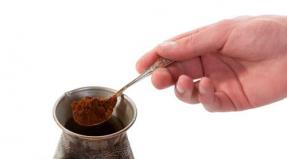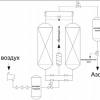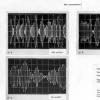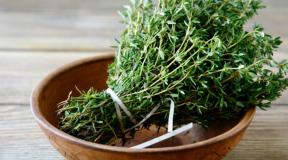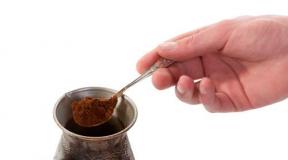Is milk high in calories? Milk for weight loss. Dry and reconstituted
Calorie content of milk: 64 kcal*
* average value per 100 ml of pure drink, depends on the type of product
Milk plays an important role in nutritious and dietary nutrition. It strengthens the immune system and helps not gain extra pounds. There are many effective diets, which are based on the use of this particular product.
How many calories are in cow, goat, soy milk?
Milk is a product rich in calcium; just one glass of drink provides daily requirement organism in this element by 30%. In addition, it contains many vitamins, enzymes, amino acids and saccharides. When choosing a drink for dietary nutrition attention should be paid to its energy value.
The calorie content of cow's milk, which is familiar to everyone, is about 55 kcal (it all depends on the fat content), goat's milk is 68 kcal.
The latter contains no less nutrients and has a specific smell. Soy milk is popular with a calorie content of 54 kcal and a fat content of 1.8% (low-fat product indicator = 28 kcal), as well as delicious coconut milk - 150 kcal with a fat content of almost 15%. 100 ml of almond milk, obtained by mixing water with almond kernels, contains about 100 kcal. The indicator increases to 135 kcal if honey and vanilla are added to the drink.
Nutritional value of cow's milk of different fat contents
The best option for dietary nutrition is skim milk, the calorie content of which does not exceed 30 kcal. A product with 1% fat content has a value of 40 kcal, and 2% has a value of about 45 kcal. The indicators are similar to those found in vegetables and unsweetened fruits. The most popular milk - 2.5% fat - contains 52 kcal, and a 3% drink - about 58 kcal.
You should not overuse a product whose fat content exceeds 5%, since the value is more than 75 kcal per 100 ml.
Fresh cow's milk (from 62 to 70 kcal) is quite difficult to find in urban areas, so many people buy a sterilized product (60 kcal) or pasteurized (no more than 57 kcal). The calorie content of baked milk is about 84 kcal, and dry milk is 460 kcal per 100 g. These 2 options are unacceptable for weight loss, in addition, frequent consumption of condensed milk, which contains almost 320 kcal, should be avoided. During the diet, in addition to low-fat, you can drink a pasteurized milk drink or a sour one (60 kcal per 100 g).
Calorie content of porridge with milk
Many people mistakenly believe that it is unacceptable to eat milk porridge while losing weight. In fact, the energy value of these dishes differs little from those cooked in water. The most nutritious - buckwheat porridge with a calorie content of 160 kcal, rice and millet are the most dietary options (96 and 88 kcal, respectively). Barley, semolina and oatmeal have approximately 100 kcal each. Read more about it in our publication.
Porridge is a hearty, tasty and nutritious dish. Thanks to the content of slow carbohydrates in cereals, you do not feel hungry for a long time. Most often, low-fat cow's milk is used to prepare porridges.
Calories in tea and coffee with milk
When brewing ground natural coffee, you don’t have to worry about your figure, because a serving contains no more than 2 kcal. Many people try to remove the bitterness of caffeine by adding all kinds of additives: sugar, cream, condensed milk or the product in question. It is these components that increase energy value drink
One cup of coffee, in which coffee and milk (3.2% fat content) are mixed in equal proportions, contains about 65 kcal.
A cup of cappuccino has 60 kcal, a glass of ice has about 140 kcal, and a latte has 64 kcal. As the fat content decreases, the value will decrease accordingly.
100 ml of green tea contains 1 kcal, and black tea – up to 5 kcal. Without additives in the drink, the value does not change, that is, the indicator does not depend on the type of tea. When adding milk with a fat content of 2.5%, significant changes– 40 kcal. As the amount of drink increases, the energy value will also change upward. Read about calories in coffee in our article.
Milk calorie table per 100 ml
Learn more about value different varieties milk, differing in fat content, and its processed products can be found in the table of calorie content per 100 g.

The value of a cup, glass, spoon of milk
The calorie content of a 250 ml glass of milk is no more than 140 kcal, and 200 ml is 30 units less. One teaspoon contains only 2.5 kcal, and a tablespoon contains about 10. As you can see, contrary to popular belief that the drink is harmful to the figure, the product is dietary. However, you need to choose only those types that have the least fat. It is inappropriate to eat condensed milk while losing weight, because one teaspoon contains almost 40 kcal.
At making the right choice depending on the type of milk and its fat content, the product can be used even with the most restrictive diet. Eating this delicious and healthy drink regularly, you don’t have to worry about excess weight and poor health.
Milk is a product that is a source of calcium. It is almost completely absorbed by the human body (97%), which confirms the beneficial properties of milk. For people suffering from osteoporosis, a disease associated with thinning of bone tissue, leading to fragility and deformation of bones, as calcium is washed out of them, the beneficial properties of milk are beneficial.
The benefits of milk
Milk is very useful for colds. From the protein included in its composition, immunoglobulins are formed that are able to fight viral infections. Moreover, milk protein is easily absorbed by the body (easier than other foods containing protein) and the calorie content of milk is not high - these are also beneficial properties of this drink.
It is this feature that has made milk a popular product for people building muscles.
Milk can be an indispensable remedy for people suffering from insomnia. Due to the fact that it contains the amino acids tryptophan and phenylalanine, this drink has a calming effect on nervous system. Therefore, to one of the many folk recipes When treating insomnia, you can take a glass of warmed milk with a spoon of honey, taken one hour before bedtime. The benefits of milk for the human body are obvious.
You can also use it for hypertension benefits of milk. It has a diuretic effect that can lower blood pressure.
What should people with gastrointestinal problems do? Will it be beneficial for them to consume milk and will they be able to experience its beneficial properties? This product, having the ability to reduce the acidity of gastric juice, will be indispensable for people with high stomach acidity, as it can eliminate heartburn. It is also recommended to drink milk for gastritis and ulcers of the duodenum and stomach with high acidity. In order for this drink to be better absorbed by the gastric juice and show its beneficial properties, it is recommended to drink it slowly in small sips, otherwise there will be no benefit.
Milk contains a lot of vitamins. The presence of vitamin B2 (riboflavin) promotes complete energy metabolism in the body, since riboflavin has the beneficial properties of converting fats and carbohydrates into energy. This means that this drink must be consumed:
When fighting excess weight (low-fat only), with impaired functioning of the endocrine and immune systems.
For people suffering from severe headaches and migraines, milk will greatly help. If you use a milk-egg cocktail as a “medicine” for a week, which includes a glass of boiling milk and one raw egg, you will forget about headaches for a long time and feel the beneficial properties of milk.
Milk is very useful for women, including those with breast disease (mastopathy). Lumps in the chest will become significantly smaller if you take a decoction consisting of one hundred grams of dill seeds and two glasses of milk for 2-3 weeks.
Many people use milk as an excellent cosmetic product. To eliminate dryness and irritation of the skin, it is useful to make milk compresses and washes. The benefits of milk in cosmetology are undeniable.
The benefits of milk for those who play sports are especially important if the goal of exercise is to gain muscle mass.
There are a large number of people in the world (about fifteen percent of the entire planet's population) who are deficient in the lactose enzyme, which is able to digest milk sugar (lactose). The body of these people cannot fully assimilate milk and appreciate the beneficial properties of milk, as well as milk sugar, and this leads to the fact that when milk enters the stomach, the fermentation process begins, swelling and rumbling of the stomach occurs, and can result in diarrhea.
Milk can cause allergies in some groups of people. It contains milk antigen “A”, which can cause a very strong allergic reaction, even bronchial asthma. People who are susceptible to allergic reactions should consume milk with caution or stop altogether. For example, with bloating, vomiting, rashes, flatulence, nausea, and itchy skin, it is impossible to evaluate the beneficial properties of milk. However, people who suffer from milk allergies are not prohibited from such healthy fermented milk products as yogurt, cottage cheese, cheeses, and kefir.
Milk can promote the formation of phosphate stones in the kidneys, thereby harming people prone to these formations. This can be detected with a simple urine test.
After the age of fifty, it is not recommended to consume milk as food, since it contains myristic acid, which promotes the accumulation harmful substances which can provoke atherosclerosis. This disease most often occurs in people over 50 years of age, so the amount of milk consumed should be reduced to a minimum. And this minimum is best consumed boiled.
Whole milk is contraindicated for people suffering from calcinosis.
Calorie content of milk
The calorie content of milk is 58 kilocalories. If you have overweight and suffer from obesity, you should not often include milk in your menu because of its calorie content. But if the calorie content of this product does not bother you, or on the contrary, you want to gain weight, then we advise you to consume dairy products, and in particular milk, as often as possible.
Healthy eating is a very fashionable modern trend, which is why many consumers refuse to include any product in their diet until they come to the conclusion that such a decision does not violate the existing balance of proteins, fats and carbohydrates, and most importantly, does not go beyond the permitted amount calories. In this regard, it is useful to know the BJU and calorie content of at least basic food products, among which, of course, is milk.
Cow
Among all types of milk, the most popular in our country is cow's milk - in most areas it has practically no alternative, which is why the main calculations are devoted to it. It should be noted that such a product is very useful - it contains all the vitamins, except E and K, as well as some useful enzymes and amino acids. Just one glass of drink provides at least 1/6 daily value calcium, it is also useful to drink milk from the point of view of enriching the body with phosphorus and molybdenum, cobalt and chromium, iodine and sodium.

The values of BJU in milk may vary somewhat, however, the indicators of proteins and carbohydrates are usually relatively stable - per 100 grams there are approximately 3 grams of the former and 3.7 grams of the latter. As for fat content, on the contrary, it is not stable - this indicator varies greatly in a natural product and, moreover, is often subject to targeted changes during the processing of milk in order to make it less calorie-rich or, on the contrary, increase its nutritional value.
The milk produced by the average cow has approximately 3.2-3.5% fat content, although some specially bred breeds have best cases They give twice as much. A packaged product may contain significantly less fat - even 0.5%. The fat content must be indicated on the packaging.


Such great attention to fat content is due precisely to the fact that this variable ingredient plays a decisive role in the calorie content of the product. It is completely logical that the less fat there is in a liquid, the less caloric it is. Skim milk with a fat content close to zero has an energy value of 30 kcal per 100 grams, but an enriched product with a fat content of 4.5% gives two and a half times more - 72 kcal. If we talk about the most popular varieties of pasteurized milk, then 1.5% is 88 kcal per glass, 2.5% is 108, and 3.2% is 118 kcal.
It should be noted that all indicators are relevant only for a packaged product, because even the same cow produces milk of different fat content throughout its life. If we are talking about fresh or whole milk, then it is not possible to accurately determine its fat content and calorie content without special equipment.

Goat
In our country, the only relatively serious competitor for cow's milk is goat's milk, but it is consumed several times less often. In its raw form, this product is drunk relatively rarely, since it is quite difficult to digest, but in general it is recommended for consumption, since it also contains an abundance useful substances, which human body are absorbed even better than from a cow product. It should be taken into account that goat milk usually somewhat fattier, and therefore its calorie content is about 132 kcal per glass.
However, goat milk is often consumed in processed form, and then its calorie content changes.

Dry and reconstituted
Powdered milk is often criticized for being unnatural, but in its best form it is prepared by simply drying normalized cow's milk, that is, it retains most of it beneficial properties. This product stores much better, and is also convenient to use for cooking. various dishes. Since we are dealing with a concentrate here, it should not be surprising that the calorie content of the powder is very high - approximately 470 kcal per 100 grams of product.
Milk obtained from dry powder diluted with water is called reconstituted milk. The exact calorie content of such a product depends on the proportion in which the powder was diluted. In fact, you should simply determine the calorie content of the amount of powdered milk used.

Ghee
This product is ordinary, most often cow's milk, which is prepared in a certain way in the oven. Something happens between boiling and prolonged digestion. During the process, a significant part of the moisture from the milk evaporates, due to which it becomes thicker and more concentrated and in this form can be used both for culinary delights and for drinking.
The calorie content of baked milk depends on the fat content of the original raw materials and on the duration of preparation, but final product always higher in calories than the original due to the lower water content. The average energy value of such a drink is estimated at 135 kcal per glass.


Condensed
Popular and beloved by many, condensed milk is somewhat reminiscent of baked milk, with the difference that sugar is also added to it. It is quite obvious that such an additive provides a significant increase in calorie content, thanks to which just 100 grams of the product contains as much as 320 kcal, although this figure may vary slightly among different manufacturers.
For this reason, people on a strict diet usually avoid consuming condensed milk.
You will learn more about the calorie content and benefits of milk in the following video.
